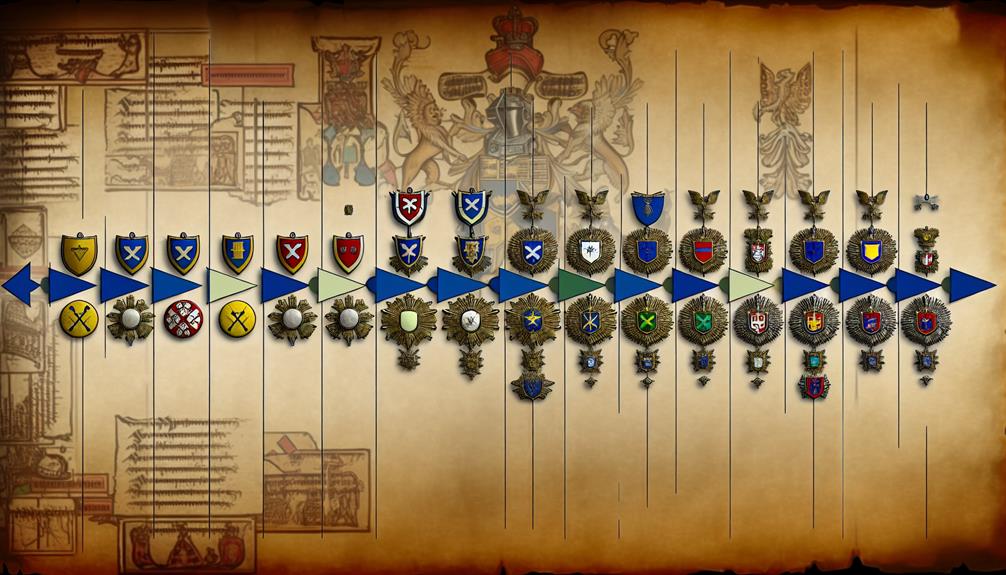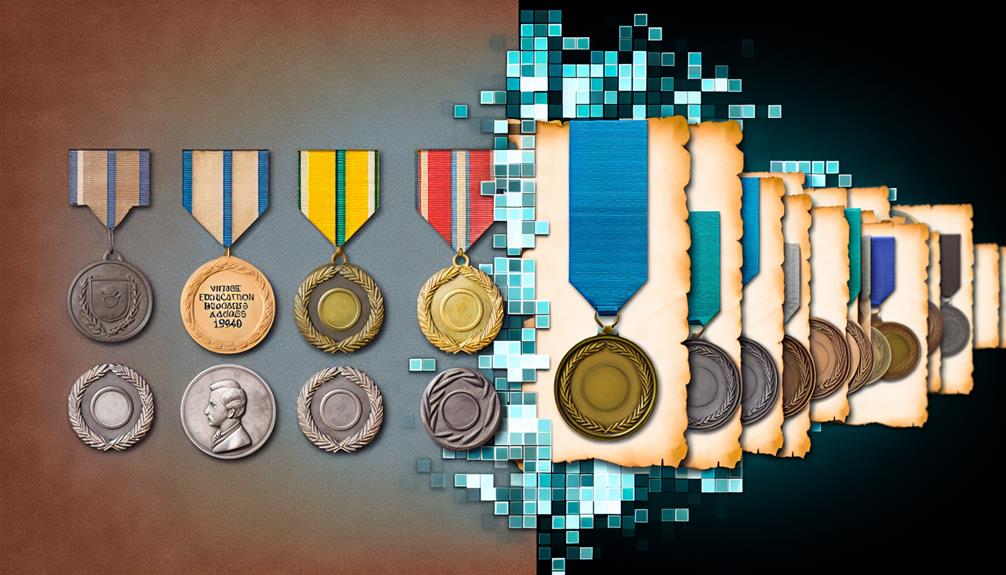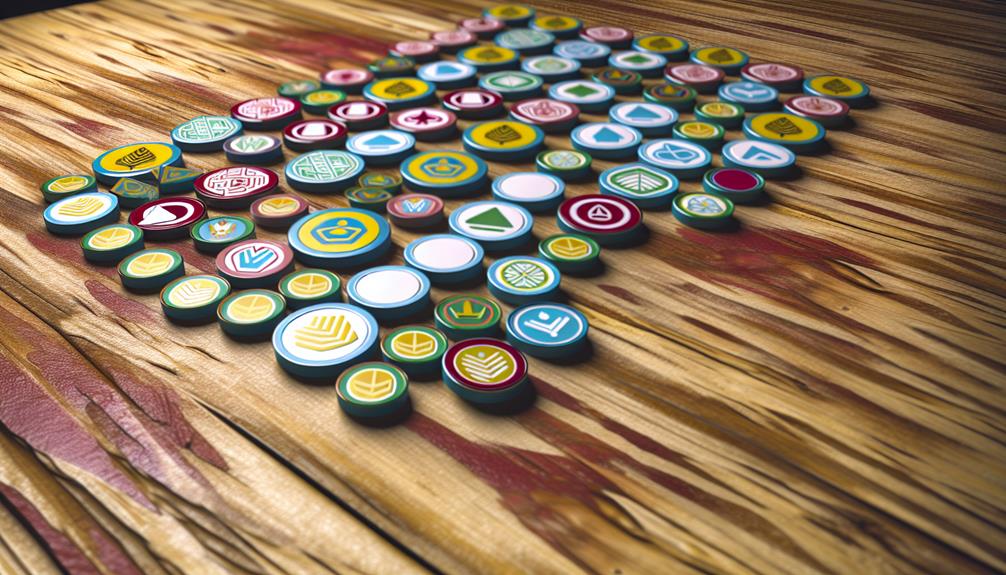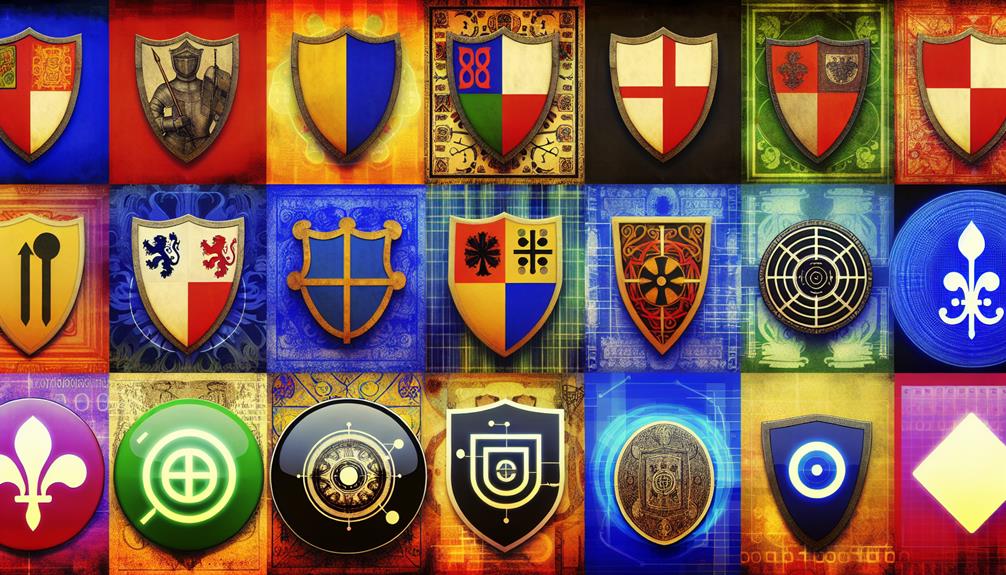Badges have evolved considerably from their historical origins as symbols of authority, identity, and affiliation. Once utilized by nobles and guilds, they now serve diverse roles across various domains. In military contexts, badges signify rank and achievement, while in education and sports, they motivate and recognize individual and collective accomplishments. The rise of digital badges has transformed them into tools for engagement within online communities, promoting continuous learning and connection. Today, badges encapsulate personal and professional growth, serving as visual markers of skills and achievements. This evolution reflects a deeper cultural significance that resonates with community values and aspirations, inviting further exploration into their impact.
Key Takeaways
- Badges originated as symbols of authority and identity in ancient civilizations, evolving through medieval heraldry and guild insignia to signify skills and allegiance.
- In military contexts, badges represent rank and achievement, fostering respect and clarity of roles within organizations.
- Educational and sports badges have transformed into tools for motivation and skill recognition, promoting engagement and a growth mindset among participants.
- Digital badges have emerged as essential symbols of achievement in online communities, enhancing learning and fostering connections among members.
- Today, badges signify personal and professional growth, acting as powerful tools for recognition, motivation, and community building across various domains.
Historical Origins of Badges

The historical origins of badges can be traced back to ancient civilizations, where they served as symbols of authority, identity, and affiliation. In the medieval period, the emergence of heraldry marked a significant evolution in badge design and significance. Heraldic symbols allowed nobles and knights to establish their lineage and allegiances on the battlefield, fostering a sense of belonging within social hierarchies. These intricate designs, characterized by unique colors and motifs, became emblematic of familial pride and social status. Additionally, the use of badges in educational contexts has gained traction, as they can promote motivation and achievement among learners, similar to the features of online tools that enhance student engagement.
Simultaneously, guild insignia arose as a means for artisans and merchants to signify their trade and craftsmanship. By displaying specific insignia, members of various guilds communicated their skills, enhancing their reputations within their communities. This practice not only promoted a collective identity among members but also reinforced a sense of trust and belonging among consumers.
As such, badges evolved from mere identifiers to potent symbols of community and individuality. They encapsulated the values of loyalty, skill, and heritage, reflecting the complex social fabric of medieval society. Through the lens of history, badges reveal the intrinsic human desire for connection and recognition, underscoring their enduring significance in our lives.
Badges in Military and Authority
Throughout history, badges have played an essential role in the military and authority, serving as visual markers of rank, achievement, and allegiance. Military insignia, intricately designed and thoughtfully positioned, convey a soldier's standing within a hierarchical structure, fostering a sense of identity and belonging within the ranks. Each insignia, whether a simple star or a complex emblem, communicates not only personal achievements but also the collective values of the unit. In addition to their historical significance, badges can also reflect the level of care and dedication found in various institutions, such as nursing care centers where services offered are indicative of commitment to those in need.
Similarly, authority symbols extend beyond the military, permeating various sectors of governance and public service. These badges signify trust, responsibility, and commitment to duty, reinforcing the social contract between the authority figures and the communities they serve. The visible nature of these symbols fosters recognition and respect, creating an environment where roles and responsibilities are clear.
As society evolves, so too does the meaning attributed to these badges. They remain essential, embodying the ideals of honor and sacrifice while continuing to adapt to contemporary values. In an age where belonging is paramount, military insignia and authority symbols serve as critical links, affirming individuals' roles within larger narratives of service and leadership.
Evolution in Education and Sports

How have badges transformed within the domains of education and sports over time? The evolution of badges in these areas reflects a growing emphasis on achievement recognition and community belonging. Initially, badges were simple tokens awarded for completing activities; however, they have since become integral in promoting skill development and fostering engagement among participants. In educational contexts, badges can support learners in understanding their progress and motivate them to engage with materials, similar to how mastering healthy meals encourages individuals to take charge of their eating habits.
In educational settings, badges serve as a tangible acknowledgment of accomplishments, motivating students to pursue both academic and extracurricular involvement. They signify mastery of specific skills, encouraging learners to embrace challenges and cultivate a growth mindset. As institutions increasingly adopt gamification elements, badges transform learning experiences into interactive journeys, enhancing motivation and retention.
In sports, badges symbolize not just participation but also a commitment to excellence. They recognize athletes' dedication and achievements, creating a sense of belonging within teams and communities. By incorporating gamified structures, sports organizations foster an environment where achievement recognition is celebrated, and personal development is intertwined with collective success.
Thus, badges have evolved from mere symbols of participation to powerful tools that enhance educational and athletic experiences, reflecting individual accomplishments while nurturing a sense of community.
Digital Badges and Online Communities
Digital badges have emerged as a transformative force within online communities, reshaping how individuals engage, learn, and connect. These digital credentials serve not just as symbols of achievement but as integral components of recognition systems that enhance community engagement. In an era where social validation is paramount, badges foster a sense of belonging, inviting members to participate actively and share their virtual achievements. Many platforms have adopted strategies that mirror successful models from industries, such as top remote customer service jobs, which emphasize skill development and recognition.
Through the implementation of gamification strategies, online platforms have encouraged users to pursue diverse skills and knowledge, leading to a richer communal tapestry. Badges signify milestones and competencies, allowing individuals to showcase their progress while inspiring others to initiate similar journeys. This interconnectedness cultivates an environment where members feel valued and recognized, reinforcing their commitment to the community.
Moreover, digital badges facilitate a culture of continuous learning, motivating individuals to expand their horizons. As users earn badges, they contribute to a collective narrative that emphasizes growth and collaboration. In this way, badges transcend mere tokens; they become essential elements that enhance the online experience, ultimately fostering a vibrant, engaged, and supportive community.
Significance of Badges Today

Badges today hold significant value as multifaceted tools of recognition and motivation across various domains, from education to professional development. Their badge symbolism transcends mere decoration; they represent accomplishments, skills, and community engagement, fostering a sense of belonging among individuals. In educational settings, badges act as visual markers of achievement, providing learners with tangible evidence of their progress and capabilities, thereby enhancing their confidence and encouraging further exploration. In innovative environments like Sphere in Las Vegas, badges can also signify advanced technological skills and immersive experiences, further enriching the value they hold.
Cultural significance also plays an essential role in how badges are perceived. For instance, certain badges may embody local traditions or communal values, strengthening social bonds and promoting shared identities. As organizations increasingly adopt digital platforms, badges facilitate global connections, allowing individuals to showcase their skills across diverse cultures and communities.
Moreover, badges serve as motivation, driving individuals to pursue new challenges and enhance their capabilities. They create a competitive yet supportive environment where personal growth is celebrated. Fundamentally, badges today are not just symbols of achievement; they are powerful tools that foster community, encourage learning, and signify personal and professional growth, reflecting both individual aspirations and collective values.
Frequently Asked Questions
How Are Badges Designed and Produced Today?
Today, badge design and badge production reflect a blend of artistry and technology, catering to diverse communities seeking identity and belonging. Designers utilize software for precision and creativity, ensuring each badge encapsulates its intended message. Production techniques range from traditional craftsmanship to advanced digital printing, allowing for customization and scalability. This approach fosters a sense of pride and unity, as individuals and groups wear badges that symbolize shared values, achievements, and collective aspirations.
Can Badges Be Used for Personal Branding?
Badges can effectively serve as tools for personal branding, enhancing one's personal identity in both physical and digital domains. By showcasing achievements and skills, badges facilitate digital recognition, allowing individuals to stand out in competitive environments. When strategically utilized, they foster a sense of belonging within communities, as individuals align themselves with shared values and accomplishments. This integration of badges into personal branding not only elevates visibility but also reinforces a cohesive narrative of professional growth.
What Role Do Badges Play in Social Media?
Badges play a pivotal role in social media by serving as symbols of achievement and community belonging. Their significance extends beyond mere digital recognition; they foster a sense of identity among users, promoting engagement and validation. By showcasing acquired skills or contributions, badges enhance personal branding and facilitate connections within networks. Ultimately, the visual representation of accomplishments through badges reinforces social ties, cultivating a shared culture where members feel valued and recognized.
Are There Any Controversies Surrounding Badge Use?
Controversies surrounding badge use primarily revolve around issues of badge authenticity and badge inflation. As digital platforms proliferate, the value of badges can dilute, leading to skepticism about their significance. Users may question the integrity of badges awarded for questionable achievements, fostering an environment where the sense of belonging is undermined. This dilution can also create disparities among users, as genuine accomplishments become obscured by an excess of easily obtainable badges, diminishing their worth.
How Do Different Cultures View Badges?
Different cultures assign varying degrees of cultural significance to badges, often shaped by historical context. For instance, in military traditions, badges symbolize honor and rank, fostering a sense of belonging and identity among service members. Conversely, in educational settings, badges may denote achievement and skill acquisition, promoting community recognition. This diversity in interpretation underscores how badges serve not only as markers of accomplishment but also as connectors within cultural narratives and shared experiences.




